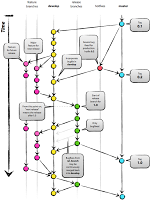Liquid Galaxy at MundoGeo in Brazil
End Point reached another milestone last week when we hosted one of our own Liquid Galaxies at a conference in Brazil for the first time. End Point brought our new Brazilian Liquid Galaxy to MundoGeo Connect in São Paulo, which ran from May 7th to 9th, 2014. MundoGeo Connect is the largest geospatial solutions event in Latin America, which this year drew almost five thousand visitors, among them businessmen, specialists, and government agencies from all over the continent. It was the perfect opportunity to showcase the Liquid Galaxy as the powerful and immersive GIS interaction tool that it is.
Similar to last year, Liquid Galaxy was the runaway hit of the show, and no one in the building left without coming around for a test flight in the Google Earth spaceship. But it was when we started showcasing the GIS functionality, the KML layers, along with other applications like panoramic imagery, embedded video, and live streaming video, that visitors really started understanding its potential for data visualizations, corporate marketing, public outreach, conference communications, and sheer immersive entertainment.
As the Latin American market continues to grow with commodities such …
visionport
git checkout at a specific date
There are times when you need to view a git repository as it was at a certain point in time. For example, someone sends your project an error report and says they were using the git head version from around January 17, 2014. The short (and wrong!) way to do it is to pass the date to the checkout command like so:
$ git checkout 'HEAD@{Jan 17 2014}' ## do not do thisWhile I used to rely on this, I no longer do so, as I consider it somewhat of a footgun. To understand why, you first have to know that the ability to checkout using the format above only works for a short window of time, as defined by the git parameter gc.reflogExpire. This defaults to a measly 90 days. You can view yours with git config gc.reflogExpire. The problem is that when you go over the 90 day limit, git outputs a warning, but them spews a mountain of output as it performs the checkout anyway! It uses the latest entry it has in the reflog (e.g. 90 days ago). This commit has no relation at all with the date you requested, so unless you catch the warning, you have checked out a repository that is useless to your efforts.
For example, the Bucardo project can be …
git
Highlights of OpenWest conference 2014
Last week I was able to not only attend the OpenWest conference, held in Orem, UT at the UVU campus, but I was also able to be a presenter. This year’s conference had their largest attendance to date and also their most diverse list of tracks and presentations. Many of the presentations are posted on YouTube.
My own presentation was on Git Workflows That Work (previous blog post, talk slides). It was part of the “Tools” track and went pretty well. Rather than recap my own presentation, I’d like to briefly touch on a few others I enjoyed.
Building a Scalable Codebase using Domain Driven Design
The folks at Insidesales.com presented on Domain Driven Design. This was something I had heard of but wasn’t very familiar with. The main principles of DDD are: understand the business purpose (not just the app requirements), rigorous organization (of code, services, design, etc.), distinct layers, and functional cohesion. The biggest point I got was that all business logic should be located in a “domain” separated from the application and separated from the data. The application is then just a thin wrapper around API calls to the business logic within the domain. DDD is different from MVC …
conference devops
Interchange form pitfalls
I’ll warn you going in: this is obscure Interchange internal form-wrangling voodoo, and even if you are familiar with that, it’s not going to be an easy trip to get from here to the end of the story. Fair warning!
Interchange form-handling has many, many features. Some of them are pretty obscure. One such is the concept of a “click map”: a snippet of named code, stored on the server. Specifically, it is stored within the user’s session, which is a chunk of storage associated with a browser cookie, and can contain all sorts of stuff—but which is primarily used for things like the shopping cart, the user’s identity, and so on.
But the tricky business here is when we put something into the session that says, in effect, “when we do this, do that, too”.
(Note: you don’t have to store your click map code in the session. In fact, it’s probably better not to, for a number of good reasons. You can put it in a sort of global configuration file, in which each individual snippet needs a unique name – which is precisely the requirement that would have prevented this bug, had I or one of my predecessors chosen to embrace that restriction.)
An Interchange page is both code and presentation (that …
interchange
MediaWiki extensions and wfLoadExtensionMessages
Upgrading MediaWiki can be a challenging task, especially if you use a lot of extensions. While the core upgrade process usually goes smoothly, it’s rare you can upgrade a major version or two without having to muddle with your collection of extensions. Extensions are bits of code that extend what MediaWiki can do. Only a few are packaged with and maintained alongside MediaWiki itself—the great majority are written by third-party developers. When the MediaWiki API changes, it is up to those developers to update their extension so it works with the new version of MediaWiki. This does not always happen. Take for example one of the more common errors seen on a MediaWiki upgrade since 1.21 was released:
[Tue May 06 11:21:52 2014] [error] [client 12.34.56.78] PHP Fatal error: Call to undefined function wfLoadExtensionMessages() in /home/beckett/mediawiki/extensions/PdfExport/PdfExport.php on line 83, referer: http://test.ziggy.com/wiki/Main_PageThis is because the wfLoadExtensionMessages function, which many extensions use, has been deprecated since MediaWiki version 1.16 and was finally removed in 1.21, resulting in the error seen above. Luckily, this function …
git mediawiki troubleshooting pdf
Drupal Commerce for Fun and Profit
Drupal has for years been known as open source content management system (CMS) for creating easy content-driven websites for any topic. In addition to the CMS, there are a whole host of tools built upon this foundation to extend the features using modules. One module in particular I worked with recently for a client was Drupal Commerce, which helps to augment the CMS with an eCommerce platform.
Within Drupal for normal content items, you would create distinct articles, which have a predefined model of fields that would reflect the different aspects of an article, author, title, tags, etc. While Drupal Commerce uses these same functions, it will also give you the capability to also define SKUs, product categories, and rules and procedures to be carried when adding a particular item to your cart. In much the same way as articles are published to the Drupal taxonomy to allow users to browse through the articles, product categories, and individual products are published, and allow the administrator to customize the layout of how those products would display.
Getting Started with Drupal Commerce
One tool that is extremely helpful on getting a Drupal Commerce setup up for yourself is …
ecommerce drupal cms
Git Workflows That Work
There was a significant blog post some years ago. It introduced a “successful” workflow for using Git. This workflow was named Gitflow. One of the reasons this blog post was significant is that it was the first structured workflow that many developers had been exposed to for using Git. Before Gitflow was introduced, most developers didn’t work with Git like that. And if you remember when it was introduced back in 2010, it created quite a buzz. People praised it as “the” way to work with Git. Some adopted it so quickly and full heartedly that they dismissed any other way to use Git as immature or childish. It became, in a way, a movement.
I start with this little bit of history to talk about the void that was filled by Gitflow. There was clearly something that drew people to it that wasn’t there before. It questioned the way they were working with Git and offered something different that worked “successfully” for someone else. I supposed many developers didn’t have much confidence or strong feelings about their use of Git before they heard of Gitflow. And so they followed someone who clearly did have confidence and strong feelings about a particular workflow. Some of …
git tips
Convert Line Endings of Mac and Windows to Unix in Rails and Test with RSpec
Line endings or newline is a special character(s) to define the end of a line. The line endings special character(s) vary across the operating systems. Let’s take an example, we are developing a Rails feedback application which will be used by a wide range of users. The users might submit the feedback from different operating systems which has different kind of line end character(s). The content should have formatted for standard line endings before storing into backend.
Mostly two special characters used to define the line endings in most of the operating systems.
-
Line Feed (LF) - \n
-
Carriage Return (CR) - \r
The usage of these two special characters for Unix, Mac and Windows are
| OS | Characters | Name |
| Unix | \n | LF |
| Mac | \r | CR |
| Windows | \r\n | CRLF |
Note:- \r is the newline character up to Mac OS version 9, after that Mac uses Unix line endings.
It is a developer’s job to convert all kinds of line endings to Unix line ending format to maintain the standard. We can achieve this by a regex pattern replace. The regex pattern should convert \r(Mac) or \r\n(Windows) to \n(Unix).
standard_content = non_standard_content.gsub(/\r\n?/,"\n")We can see the conversion of line …
ruby rails testing









